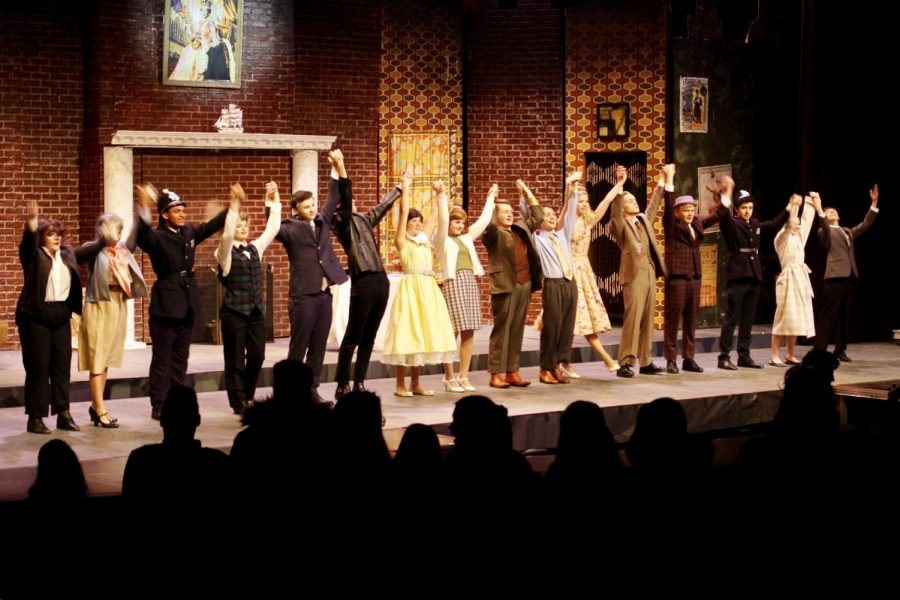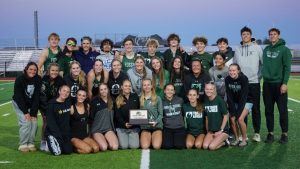Review: One Man, Two Guvnors brings laughter to Fossil Ridge
The cast of One Man, Two Guvnors takes a bow.
April 13, 2019
Comedy is a hard thing to pin down. At its root, it can be difficult to explain why exactly something is or isn’t funny—one just knows, deep within, whether something succeeds in being humorous and amusing.
One Man, Two Guvnors opened as the Fossil Ridge High School Theatre department’s first straight comedy, taking a daring step away from anything the school has put on before. The play features audacious and daring elements, such as music and audience involvement, and though some jokes drag on or fall flat, it does not fail to entertain and amuse audiences.
One Man, Two Guvnors is an English adaptation of an eighteenth-century Italian comedy, Servant of Two Masters. The play opened in London in 2011, featuring James Corden as the title character. The Fossil Theater department staged their production this weekend, opening Thursday, April 11 after a blizzard canceled the preceding teacher showing. The play itself is Shakespearean in nature; there are mistaken identities, interchangeable sets of twins, and arranged marriages.
The play begins as a spotlight cuts through the darkness—on the edge of the stage, the skiffle band (with Cade Frevert on bass, Blake Rouse on guitar, and Espen Marston on washboard) commences its serenade. Each scene that follows begins in this manner, with the three-man band playing out folkish melodies. These musical elements are unexpected, but impress as they set a lighter mood from the beginning—Rouse’s voice and the ragtag combination of instruments create an appealing sound while maintaining a striking authenticity.
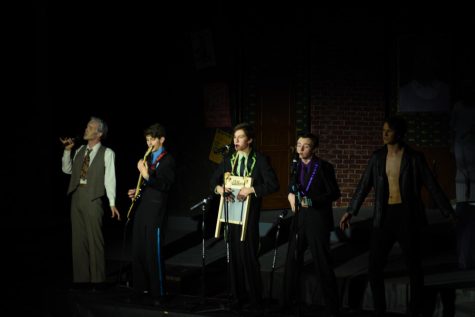
The skiffle band, accompanied this time by Tom Houser as Harry Dangle and Jack Kraus as Alan Dangle, takes the stage.
One Man follows the misadventures of Francis (Parker Bennett), who finds himself in the service of two separate characters and spends the play navigating the struggles of performing both sets of duties simultaneously. The opening scene introduces us to the central characters and the conflict that drives the plot behind Francis’s shenanigans. Pauline (Amelia Overholt) has been arranged in an upcoming, unwanted marriage with the notorious Roscoe Crabbe by her father, Charlie “The Duck” Clench (Lucas Feuer). She expresses her frustration with this agreement (“You can’t force me to marry a dead homosexual!”), as she has since fallen in love with the eccentric actor Alan Dangle, portrayed by Jack Kraus. However, this plan is interrupted, to the delight of Pauline: Roscoe has been killed by the boyfriend of his twin sister. This situation creates confusion when Roscoe shows up, risen from the grave (but who, as we soon find out, is actually his twin sister, Rachel, Azelan Amundson, masquerading as her dead twin brother). Thus begins the following series of events, which are complex enough to make the Bard himself scratch his head.
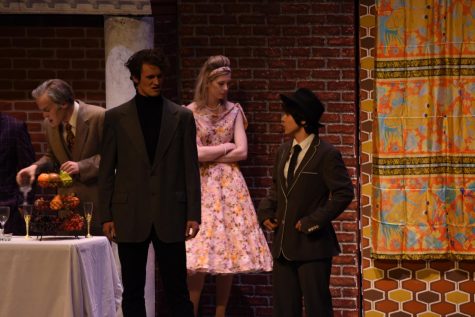
Alan Dangle (Jack Kraus) quarrels with Roscoe/Rachel Crabbe (Azelan Amundson).
From the beginning, the audience is drawn into a convincing and immersive scene: the set, the costumes, the characters, and the props persuaded the audience to believe that they were watching a scene from Brighton in 1963. The backdrop, which catches attention from the moment it is visible, radiates setting via infinitesimal detail and texture, a series of brick walls creating an English skyline. Though this setup seems a bit more rickety than one would expect of a brick wall at intermittent points in the production, the set seamlessly transitions between scenes, effectively switching setting while maintaining the underlying structure. In terms of acting, each player added to the atmosphere by sustaining convincing accents throughout. Dialects are something that can often be overlooked but which completed the effective anglicization of the play.
As the first act progresses, Bennett steps into the role of Francis as he finds himself in the employment of the two titular “guvnors” —who, as it turns out, are the disguised Rachel Crabbe and her betrothed, Stanley Stubbers (Austin Hand). Comedy ensues as Francis juggles his dual roles, encountering befuddlement at every single opportunity and mixing up orders from the two characters. Though Francis experiences difficulty with every task given to him, Bennett establishes his character quite effectively. Through his drunken stumbling, nonsensical dialogue, and frequent asides, Francis becomes the jester, a foolish figure who serves as a connection between the audience and the play. Though this absurdity seems overplayed at times, we are given a fitting protagonist for a comedy of this sort.
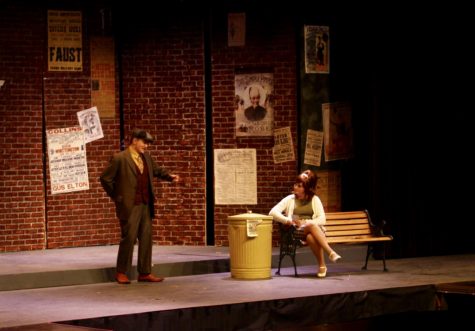
Francis (Parker Bennett) courts Dolly (Olivia Zadkovic) as “Patty”.
As the fourth scene of the first act begins, the central conflict of the play temporarily takes an unexpected detour. As Francis simultaneously serves both of his employers in a restaurant, his focus shifts from the balance of his two governors to pocketing food from the plates of both. As the scene progresses, he adopts an appetite-obsessed mentality resembling that of Shaggy from Scooby Doo—so much so that he posits in the beginning of the next scene: “If the harlequin—that’s me—has eaten, then what’s my motivation in the second act?” This lends itself to the natural humor associated with any single-minded pursuit of food, and is compounded by the whimsical actions of the comically elderly Alfie (Ben Ashby).
A distinctive and distinguishing element of the play is its audience interaction: throughout, characters frequently address and banter with members of the audience through soliloquies, even going so far as to invite select attendees to join the play themselves onstage. This phenomenon keeps the audience tightly engaged, as they watch the cast members adapt to the audience, and adds an extra level of hilarity, to the point where one wonders (especially in certain, particularly uproarious episodes towards the end of the first act) if the audience members used are in on a conspiracy with the theatre department—would they really be able to do that without some amount of planning? However, in points of more underwhelming audience involvement, the practice starts to make the play seem inexplicably more like a magic show—audience members were brought on stage to perform tasks that seemed to gain little from their involvement as Bennett prompted them. This aside, the audience engagements added an appreciated layer of intrigue and humor.
The technical aspects of the One Man pulled together smoothly, ultimately creating a rather impressive effect. Aside from a couple instances of mic failure, which left actors sporadically unheard, tech was without any obvious flaws. The combination of era-appropriate costumes, compelling make-up (particularly for aged characters), and rather attention-drawing hairstyles comes together to create a visual effect fitting both for the genre and the setting. Even props, such as the vintage trunks that appear as the luggage for Stanley Stubbers and Rachel Crabbe or the food served in the final scene of Act I, create authenticity within the play.
On stage, many actors stood out, making memorable impressions in their roles. While Bennett stepped naturally into the leading role of Francis, providing humor akin to that of the Three Stooges, other thespians created a diverse range of eccentric and intriguing characters. Take, for example, Kraus, who played the bizarre and dramatic aspiring actor Alan Dangle by strutting across the stage in a manner not unlike a chicken, or Hand, who plays the cool and collected criminal Stanley Stubbers, and who shows moments of striking somberness amidst the many jokes in the second act. And then there is Olivia Zadković as Dolly, the free-thinking and assertive secretary of Charlie “The Duck,” who brings in feminist monologues and quips. All around, the comedy in One Man was built upon the cast of odd characters that conveys it.
At its core, One Man is all about comedy—it aims not to tell a meaningful or impactful tale, but to make audiences laugh. In some points, this attempt falls short: jokes with crude humor fail to impress or running gags run on too long. However, with hilarious characters and preposterously unexpected stunts, the play succeeds resoundingly in delighting audiences.



